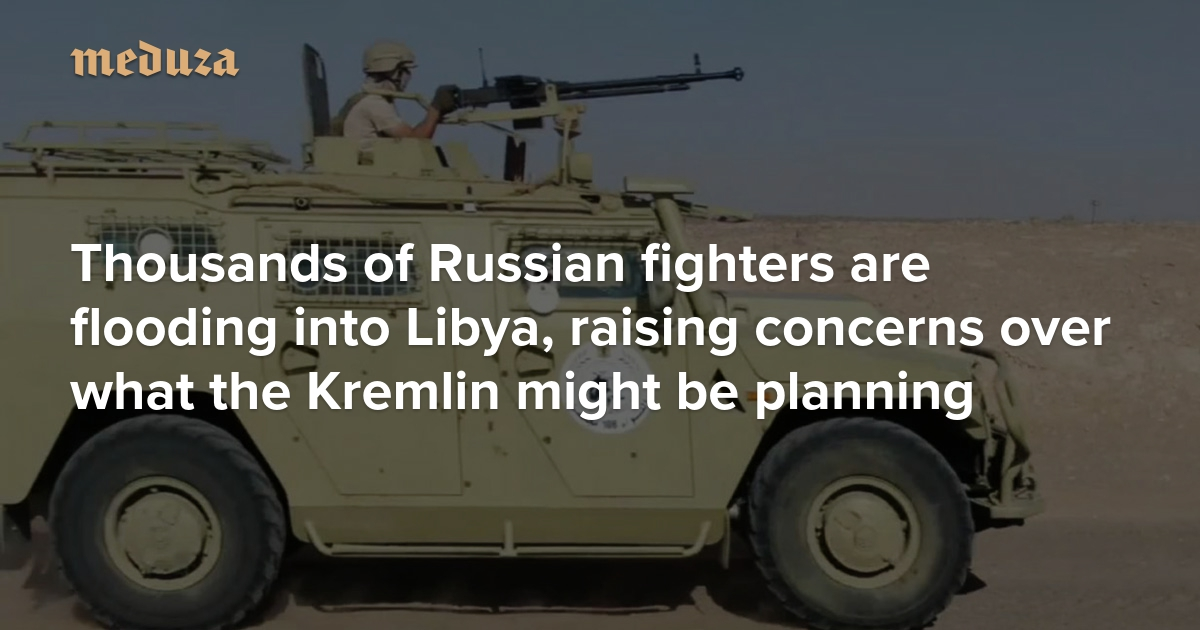Russia has been bolstering its military presence in Libya for the past few months, according to an investigation. Libya has been mired in civil war since the fall of Muammar Gaddafi in 2011, and Russia has long been accused of meddling in the conflict. Now, the Kremlin appears to be shipping more military equipment to Libya and the surrounding region and redeploying regular troops disguised as mercenaries, along with recruits from Wagner Group’s Africa operations.
The increased military activity in the region may also have something to do with increased pressure for Libya to hold elections. While there have been several attempts to hold elections, plans have often been delayed or disrupted due to escalations in the military conflict. The U.N. has urgently called for elections to be held to prevent the country from sliding further into war.
'Tectonic shifts’
In the past three months, Russia has begun actively transferring military personnel and mercenaries to Libya, according to Verstka’s findings. These forces are primarily concentrated in eastern Libya, a region under the control of Khalifa Haftar, the commander of the Libyan National Army and a Kremlin ally. (The western part of the country, including the capital, Tripoli, is governed by the U.N.-recognized Government of National Accord.)
A source within a Libyan security agency reported that at least 1,800 Russian military personnel have arrived in the country in the last two weeks alone. Some were dispatched to Niger, while others remain in Libya awaiting further orders.
One serviceman told journalists that he and several hundred other special forces soldiers were redeployed from Ukraine at the beginning of the year. Several thousand more fighters — both professional soldiers and mercenaries from Wagner Group’s Africa operations — arrived in Libya between February and April. In conversations with journalists, the soldiers themselves acknowledged that their presence in Libya is unofficial. They said that they’re there as part of a private military company, though they didn’t specify which one.
Russian military personnel and equipment have been spotted in at least 10 locations in eastern Libya since the beginning of March. Russian troops are stationed around major military bases, such as Al Jufra Air Base and Ghardabiya Air Base, as well as near smaller ones by Waddan and Marj.
Sources say that some of the newly arrived Russian military personnel are involved in training local soldiers and new recruits from private military companies. Others are carrying out combat missions, such as securing the transport of military equipment.
“There’s never been such a fuss; tectonic shifts are happening here,” one Russian soldier in Libya commented. “I think a big mess is brewing.”
Following the breadcrumbs
Location data from Telegram users show an increase in activity around military sites in Libya. On March 5, a Russian soldier with the username “Andrey” showed up near the Ghardabiya Air Base near Sirte. A few months before, “Andrey” was in Mulino — a city in Russia’s Nizhny Novgorod region where soldiers are being trained for combat in Ukraine. Nearly two weeks after “Andrey” appeared at Ghardabiya Air Base, the Libyan National Army conducted military exercises there.
Soon after, another group of Russian soldiers was spotted in Marj, Libya. On March 17, photos of them were posted on Libyan social media; Verstka and its investigative partners were able to geolocate these photos by comparing the buildings and structures in them with satellite images.
In early May, geolocation data confirmed the presence of two Russian soldiers in Jufra. One of them was the same “Andrey” who’d been at the Ghardabiya Air Base in March. He stayed there until at least April, then moved to Jufra by May.
The second soldier in Jufra was 26-year-old Pavel Vavilov from Russia’s Vladimir region. It’s likely that Vavilov entered the military recently: leaked data shows he worked as a security guard in 2020, and before that, as a taxi driver. He’s faced various legal issues, including a theft conviction. Another Telegram account linked to Vavilov shows a car with a license plate from the self-proclaimed “Luhansk People’s Republic” in the profile picture.
In recent weeks, there’s been a notable increase in shipments of Russian weapons and transport vehicles from Syria to Libya. In photos published on March 30 by the Russian pro-war Telegram channel Military Informant, several Russian Tigr armored personnel carriers can be seen being used in Libyan National Army exercises. Judging by the unit insignia on the front doors, they were delivered to the Libyan National Army’s 106th Brigade.
The channel also released video footage of the exercises. After comparing the terrain, buildings, and landmarks seen in the video to satellite images, Verstka and its investigative partners determined that the footage was shot between Al Jufra Air Base and the town of Waddan.
Russia is shipping a large amount of military equipment to Libya by sea. A source told Verstka that he had personally escorted equipment from a “military port” to various “military bases.” In some cases, the equipment comes to Libya via Syria’s Tartus port. For instance, on April 2, two Russian landing ships — the Alexander Otrakovsky and the Ivan Gren — were spotted in Tartus. On April 6, the same ships were off the coast of Crete, and on April 8, they arrived at the Port of Tobruk in Libya. These vessels were transporting vehicles and weaponry; one item in the shipment resembled a Soviet-era 2S12 “Sani” heavy mortar system. According to open-source investigators, this marked the fifth such shipment in the last six weeks. Satellite imagery shows that since then, the ships have continued to make trips back and forth.
Jalel Harchaoui, a Libya expert at the Royal United Services Institute (RUSI) think tank, drew attention to the fact that Russian military personnel are being redeployed to the Brak al-Shati base in Libya. According to him, the number of Russian-speaking personnel at the base has increased by about 25 percent in recent weeks.
Back in March 2024, investigators from the All Eyes on Wagner project didn’t find any Russian Telegram accounts at the base. However, the situation has changed in the last few weeks. For example, in early May, an account registered to a Russian number was discovered near the base. The user, 28-year-old Russian Maxim Kukol, doesn’t appear to have been connected to the military before 2021. But there’s no public record of his employment after this. However, by 2022, his debts had been cleared.
Geolocation data also shows a steady stream of Russian military personnel arriving at the Tartus port in Syria, which has become a kind of redistribution hub for military resources. Among them is 19-year-old Navy serviceman Anton Zaikin, who was stationed in Baltiysk, in Russia’s Kaliningrad region, in early 2024. By early May, he had relocated to Syria.
A strategic move
Turkey, the U.S., and other countries have repeatedly accused Russia of interfering in the Libyan conflict, including through the use of Wagner Group mercenaries. Journalistic investigations have confirmed that Russian mercenaries have been present in Libya since at least 2019, and experts say the Kremlin has been supporting Khalifa Haftar since around 2018.
In 2023, Russian officials and Haftar held their first public negotiations since the start of Russia’s full-scale invasion of Ukraine. In August, Russian Deputy Defense Minister Yunus-bek Yevkurov met with him in Libya, and in September, Haftar met with Russian President Vladimir Putin in Moscow. Following this, there were multiple media reports of Kremlin plans to build a Russian naval base in Tobruk, Libya (where Russian military cargo arrives from Syria).
In January 2024, shortly before Russia began sending large numbers of troops to the region, Yevkurov visited Libya again. He met with Haftar in Benghazi; Verstka’s sources say that a new Russian military training base is already operating not far from this city. According to Verstka and All Eyes on Wagner’s sources, the Russian contingent in Libya is controlled by four commanders who were previously in Syria. They, in turn, report to Yevkurov.
"I think the Russians are betting on a war inside Tripoli among the militias, so they’re going to shift gears,” said one military source. Another source suggested that the current influx of Russian equipment and the repositioning of troops are intended to supplant Wagner Group forces in Libya and pave the way for further deployments to other African countries.
RUSI’s Jalel Harchaoui noted that an increased presence in Libya aligns with many of Russia’s strategic regional interests. “Libya offers extremely valuable access to the Mediterranean Sea, acts as a southern flank to exert pressure on NATO and the E.U., and strengthens dialogue with other key Arab countries,” he explained. “Importantly, it also serves as a gateway to Sub-Saharan African countries, offering a strategic route to countries like Sudan, Niger, and beyond.”
According to him, cooperating with the Haftar family allows the Kremlin to achieve these goals while minimizing costs. “Roughly speaking, the Haftar family rewards Moscow materially and financially for doing things that are already in its interest,” Harchaoui believes.
The increased military activity in the region may also have something to do with increased pressure for Libya to hold elections. While there have been several attempts to hold elections, plans have often been delayed or disrupted due to escalations in the military conflict. The U.N. has urgently called for elections to be held to prevent the country from sliding further into war.



They can. Raw manpower has never been their problem.